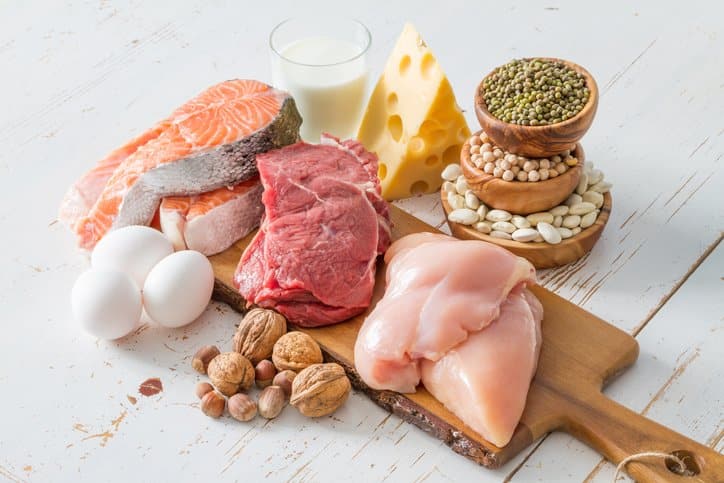Oh boy…this is the question that has launched a thousand diet wars!
Setting aside all of the dietary dogma out there for a moment my simple answer to this question is “listen to your body”.
That is step one.
If you are not eating enough protein you will most likely be tired and hungry. You will also probably have a lot of cravings (not necessarily for protein though).
Another hint is that you might have a hard time gaining muscle even if you are doing resistance training.

Pay attention to these simple signs. If you find them to be true I suggest increasing your protein by 5 grams or so at each meal and seeing how you feel. That would translate to about another 1 ounce of meat or fish, one small egg, 1/2 cup of beans, 3 TBSP of parmesan, cheese, OR 2 TBSP of hemp seeds at each meal.
This feedback loop will be very quick because our protein needs are on a 1-day cycle. This means, you’ll see a difference right away, which is awesome!
If you feel less hungry and less tired and have fewer cravings after a day or two of eating more protein, voila, you have your answer!
If you work out a lot, have a chronic illness, or have a lot of stress in your life, you may find that your protein needs are relatively high.
Here I do have to insert that this article is not a substitute for working with a qualified healthcare provider to find your ideal protein intake. This article is for educational purposes only. So please consult with your nutritionist or doctor about this!
But now for some research!
The government has set up dietary recommendations for protein intake. The recommendations are based on getting the MINIMUM protein intake. It is based on something called “nitrogen balance”.
Nitrogen balance is the conventional measure of protein needs used in crafting the RDA, and it reflects efficiency of nitrogen retention under conditions of energy balance (12–14). In this context, additional protein intake above that required for attaining nitrogen balance has been viewed as unnecessary or possibly unsafe.(1)
There are many researchers out there that argue that nitrogen balance is NOT the ideal way to measure protein needs. And there is a whole ton of research around why that is and better ways to measure what the ideal protein amounts are. (1)
The general takeaway from this research is that the RDA is really just about the minimum and not about optimizing health and aging.
And that your protein needs can vary based on many variables such as your age, the amount and type of physical activity you get, and whether or not you have any chronic or acute illnesses.
You might be wondering what foods are best to eat for protein. The following list is of PRIMARY protein sources.
- Meat
- Poultry
- Fish/Seafood
- Eggs
- Legumes (beans, peas, lentils, etc)

I always recommend that you eat at least one primary source of protein at each meal so that means including meat, poultry, fish/seafood, eggs, or legumes at EACH MEAL.
Adding some dairy, nuts, or seeds can enhance your protein consumption but they are not sufficient for a full serving of protein. This is because you’ll have to eat a lot of them to get an adequate amount and that can be difficult to do or too calorically intense.
Veggies, whole grains, and fruit also contain protein so they add to the tally, but again, they should not be considered a primary source of protein.
Eating 4-5 oz of meat, poultry, fish, or seafood will provide about 25-35 grams of protein. One egg contains about 6 grams of protein so you’ll probably have to eat a few. Add some dairy, hemp seeds, or beans, and some veggies and you should be getting sufficient protein.
1 cup of black beans or chickpeas will give you about 14 grams of protein. Again, adding a whole grain and/or some dairy and some veggies will bring you up to a decent amount of protein.
Research also shows that generally speaking, it looks like we should be spreading out our protein intake evenly throughout the day. (1)
So if your goal is 100 grams of protein per day it is best to eat about 33 grams of protein at each meal (for 3 meals).
Currently, most Americans eat about 60% of their protein at dinner.
It has also been found that healthy adults would have to eat a LOT more protein than the average American does to reach what is known as an Upper Limit (UL). The UL for protein has not been established by the government but research shows that it would be well over 300 grams per day. (1) Don’t worry, you’re not eating over 300 grams of protein per day. That is not easy to do!
The average US consumption rate for women is 68 grams per day for women and 98 grams per day for men. (1)
According to the RDA, we should be eating a minimum of .8 grams of protein per kilogram of body weight. This means that a woman weighing 150 pounds should be eating 120 grams of protein per day.
If you have overweight or obesity you’ll need to base your protein target on your ideal weight. Not a super thin weight, YOUR ideal weight. What is the weight where you feel strong and vibrant? Start with that number.
So let’s say you weigh 200 pounds and your ideal weight is 150. Then you should be eating at least 120 grams of protein per day, not 160 (which would be based on your current weight).
As you can see, most women are not eating anywhere near the target for protein intake.
BUT these recommendations are general and they may not apply to you exactly. They are just some guidelines for you to try out.
The most important thing is that you feel better, you are SLOWLY losing weight, and you have lots of energy.
Also, pay attention to your gastrointestinal health. Sometimes eating more protein can be tough on digestion for people. You may need to add some digestive enzymes with HCL (stomach acid).
Of course, you should work with a healthcare professional to determine your ideal protein intake, these are just general suggestions.
The big point I want to make here is that many women in particular are NOT eating enough protein.
And this is a problem because eating sufficient protein can help you build muscle, it can help reduce hunger and cravings, and help you feel satisfied with your meals. This is huge!
Protein is a secret weapon! And you would have to eat WAY more protein than you would ever want to in order to reach the upper limit.
But again, I go back to the start of this article. Pay attention to how you feel.
Protein can practically be like a magic bullet for you, helping you get stronger, have fewer cravings, be hungry less often, and even improve your mood!
Rather than trying some fancy, complicated diet, how about just slowly increasing your whole-food-based protein intake a little bit and seeing how you feel?
As I’ve mentioned before in other articles, I’m all about ADDING nutritious, whole foods before talking about taking things away.
If you need help with increasing the whole foods in your diet, read this blog post.
In our WYN Program, you get the guidance and support you need to start developing the list of healthy habits that will keep your metabolism as balanced as it can be and to age with vitality and energy.
We provide you with the accountability you need to make progress in the 5 areas of health mentioned above:
- Nutrition
- Physical Activity
- Sleep
- Stress Management
- Mindset
If you would like to learn more about our program I invite you to book a call with me. Just click below.
REFERENCES
- Layman DK, Anthony TG, Rasmussen BB, Adams SH, Lynch CJ, Brinkworth GD, Davis TA. Defining meal requirements for protein to optimize metabolic roles of amino acids. Am J Clin Nutr. 2015 Jun;101(6):1330S-1338S. doi: 10.3945/ajcn.114.084053. Epub 2015 Apr 29. PMID: 25926513; PMCID: PMC5278948.
